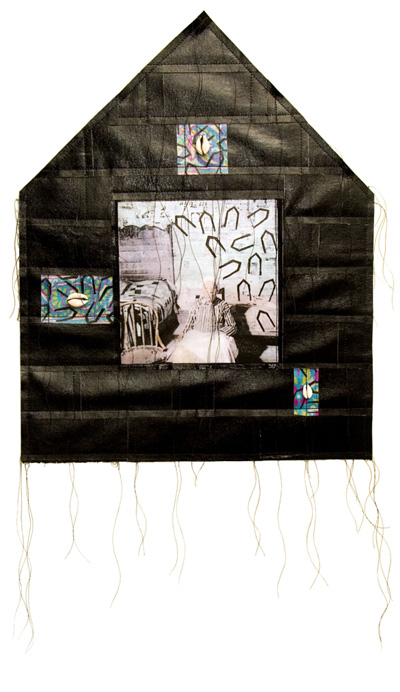BACK TO QUILTS
Walls Talking: Mulatto Ex-Slave in Her House Near Greensboro, Alabama; house
CITE THIS QUILT

QUILT INDEX RECORD
12-8-5026
Who documented this quilt?
Michigan Quilt Project; Michigan State University Museum Collection; Quilts and Human Rights; Black Diaspora Quilt History Project
Where are the records for this quilt housed?
Michigan State University Museum
Michigan Quilt Project Number:
08.0020
If this quilt is owned by a museum, enter the accession number:
2008:160.1
Object label:
Walls Talking: Mulatto Ex-Slave in Her House Near Greensboro, Alabama
Keisha Roberts
San Fransisco, California
2006
Collection of Michigan State University Museum acc.#2008:160.1
Essay:
Born into a social system that deemed her and millions like her chattel, the nameless, formerly enslaved woman in the central image of this quilt endured what seems unendurable. If her walls could talk, perhaps they would tell us how she fought to outlive a system that owned her life, then struggled through the dark years that followed to build a home and a future.
--Keisha Roberts
Quilt's title:
Walls Talking: Mulatto Ex-Slave in Her House Near Greensboro, Alabama
Names for quilt's pattern in common use:
house
Quilt top made by:
Roberts, Keisha
Quilted by:
Roberts, Keisah
If you are the quilt owner, how did you acquire this quilt?
Received as a gift
Where the quilt was made, city:
San Fransisco
Where the quilt was made, state:
California (CA)
Where the quilt was made, country:
United States
Time period:
2000-2025
When was the quilt finished?
2006
Why was the quilt made?
Art or personal expression
Quilt is presently used as:
Museum collection
Quiltmaker's gender:
Female
Quiltmaker's city:
San Fransisco
Quiltmaker's state:
California (CA)
Quiltmaker's birth date:
1977
Quiltmaker's ethnic background/tribal affiliation:
African American
Quiltmaker's educational background:
Roberts holds degrees in African and African American Studies, History, and Women’s Studies, and a certificate in CommunicatioRoberts holds degrees in African and African American Studies, History, and Women's Studies, and a certificate in Communications from Duke University, as well as a graduate certificate from The George Washington University's Museum Studies Program in Collection Care.
Other notes on how the quiltmaker learned, and how and why they quilt:
Keisha Roberts draws inspiration from African and African American history and culture, and the striking graphic composition of African textiles. Roberts forges passions for art, history, and culture into fine art, exhibition experiences, research projects, lectures, workshops, and works of non-fiction. Roberts’s current abstract and photographic quilt art is a synthesis between figurative and conceptual elements. Roberts infuses personal, familial, and cultural memory into each contemporary quilt, while incorporating the continuity and tradition of generations of quiltmaking. She is also creating quilted sculptures and integrates glass, ceramics, and encaustic in her work to create quilted, mixed media works of art. Roberts was the project coordinator for the nationally heralded oral history project Behind the Veil: Documenting African American Life in Jim Crow South at the Center for Documentary Studies at Duke University. She wrote the chapter Resistance and Political Struggles in the book Remembering Jim Crow: African Americans Tell About Life in the Jim Crow South, which won the Southern Regional Council’s Lillian Smith Book Award, the Multicultural Review’s Carey McWilliams Book Award, and the Library Journal’s Best Book of 2001 award. She has curated and exhibited in solo, group, and traveling exhibitions across the country. Her work is held in private and public collections in the United States and South Africa.
This is a:
Finished quilt
How wide is the quilt?
15"
How long is the quilt?
19"
Shape of edge:
Straight
Shape of corners:
Straight
What color is the quilt?
Black; Gray; Pink
Quilt's condition:
Very good/almost new
Describe the quilt's layout:
Medallion or framed center
Fiber types used to make the quilt top:
Cotton
Describe the techniques used to make the quilt top:
Mixed media techniques
Materials used to make the back:
Cotton
How is the binding made?
Edges turned in/ no separate binding
Features or notes about the quilt's appearance, materials, or construction:
Born into a social system that deemed her and millions like her chattel, the nameless, formerly enslaved woman in the central image of this quilt endured what seems unendurable. If her walls could talk, perhaps they would tell us how she fought to outlive a system that owned her life, then struggled through the dark years that followed to build a home and a future.
Exhibitions where this quilt was displayed:
Quilts and Human Rights, Michigan State University Museum, January 15 - August 24, 2008
Source of the information on this quilt:
Museum employee
Ownership of this quilt is:
Public- Michigan State University Museum
Quilt owner's name:
Michigan State University Museum
Quilt owner's city:
East Lansing
Quilt owner's county:
Ingham
Quilt owner's state:
Michigan (MI)
Quilt owner's country:
United States
How was this quilt acquired?
Purchase
Tell the story of how the quilt was obtained:
Tricia Stoddard, author and researcher, 4/18/2008
Access and copyright information:
Restricted
How did the quiltmaker participate in the creation of the quilt?
Made entire quilt
Where did the quiltmaker find the pattern for the quilting design on this quilt?
Original to maker
Who photographed this quilt?
Frankye Riley
Copyright holder:
MSU Board of Trustees
Cite this Quilt
Roberts, Keish. Walls Talking: Mulatto Ex-Slave in Her House Near Greensboro, Alabama. 2006. From Michigan State University Museum, Michigan Quilt Project; Michigan State University Museum Collection; Quilts and Human Rights; Black Diaspora Quilt History Project. Published in The Quilt Index, https://quiltindex.org/view/?type=fullrec&kid=12-8-5026. Accessed: 04/19/24
-
Collection
African American Quilt Collection
Michigan State University Museum
-
Exhibit
Quilts and Human Rights
MacDowell, Marsha; Worrall, Mary; Swanson, Lynne